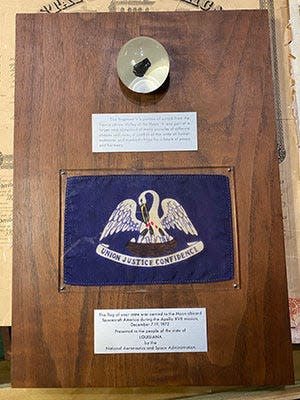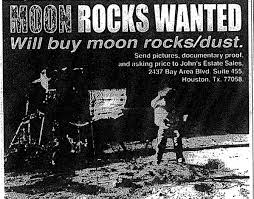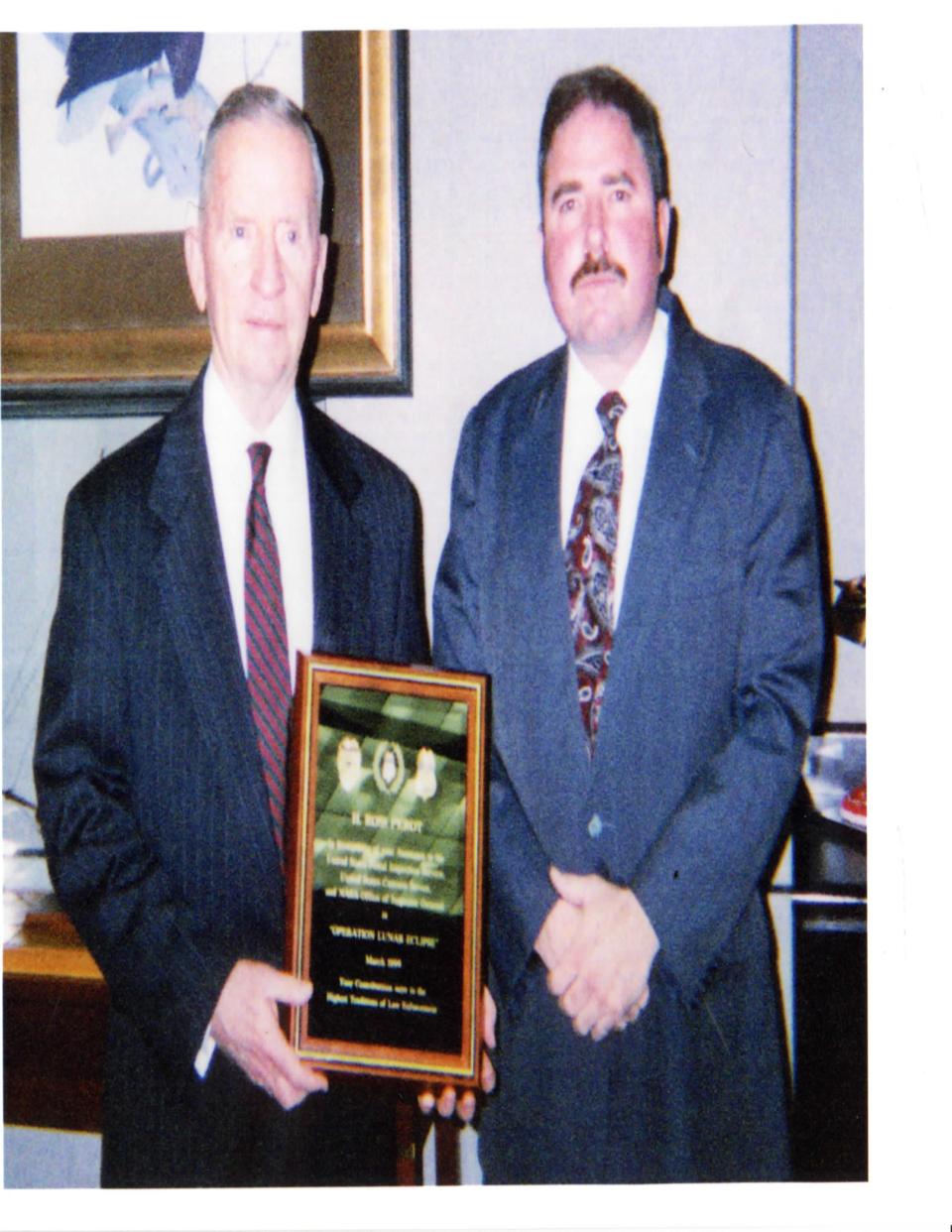Missing and worth millions: Plucked from the moon, dozens of lunar rocks have disappeared
- Oops!Something went wrong.Please try again later.
They are among the rarest items on Earth, worth millions of dollars on the black market.
They've been at the center of stings, swindles and high-profile heists.
Still others have been stashed away in garages or storage units untouched for years or possibly decades.
They've been handled by presidents and kings, dictators and mercenaries, school kids and scholars.
One example is in the Oval Office at the White House. Another is buried somewhere in a garbage dump outside Dublin, Ireland.
Yes, the Apollo moon rocks have continued to make intriguing journeys even a half century after making the quarter-million mile trip to Earth.
Moon rocks: What to do if you think you have a lunar souvenir collected by Apollo astronauts
Neil Armstrong, Buzz Aldrins and Michael Collins: Men on the Moon
Most of the 842 pounds of lunar rocks and soil brought back to Earth by the 12 astronauts to walk on the moon remain in NASA's hands. Small amounts reside in museums or other public sites such as the Kennedy Space Center Visitor Complex.

But following the Apollo 11 mission and again after Apollo 17, then-President Richard Nixon asked NASA to create individual displays of lunar material to be shared with some 135 different nations as well as individual U.S. states and territories.
But of the nearly 400 or so displays created, almost half have gone missing.
Missing moon rocks made the news in September when the story broke about a Merritt Island man who realized he had Louisiana's Apollo 17 display, and that he had likely had it sitting in a box in his home for years.
The man, who wishes to remain anonymous, is a gun collector. He buys wooden plaques at garage sales in order to salvage the wood to replace or repair damaged gun stocks. Since he is interested in the wood, he generally doesn't pay much attention to the inscriptions on the plaques.
But recently, as he was digging through the 15 or 16 boxes of plaques he had, a Lucite ball attached to one caught his eye.
Man on Moon: 'That's One Small Step for Man, One Giant Leap for Mankind'
Bring a newspaper to the moon? NASA said no, LBJ said no. Astronaut Alan Shepard said yes.
A metal plate on the plaque explained that this was something more than an award for winning a local pub darts league:
"This fragment is a portion of a rock from Taurus Littrow Valley of the Moon. It was part of a larger rock composed of many particles of different shapes and sizes, a symbol of the unity of human endeavor and mankind's hope for a future of peace and harmony."
Inside the Lucite ball was a sliver of a rock had been brought back to Earth in 1972 by Eugene Cernan and Harrison Schmitt, the last two men to walk on the moon.
Last man on the moon, NASA astronaut Gene Cernan, died in 2017
The plaque also had a small Louisiana flag that had flown to the moon on Apollo 17 and another metal plate dedicating the plaque to the people of Louisiana.
Through a friend, the man contacted space historian Robert Pearlman, who runs the website collectSPACE.com , to verify that he had an actual moon rock.
"I was really expecting my answer to be, at the end of the day, that this was not a real moon rock," Pearlman told FLORIDA TODAY. "I get contacted about three or four times a month, with inquiries saying, 'I've found a moon rock,' and almost 100% of the time, it's my telling them 'No, that's not a moon rock.'"
But when the man sent Pearlman a picture of the plaque, Pearlman changed his tune. "The moment I saw the photo, I knew that I was looking at the real thing."
The plaque is now in the possession of the Louisiana State Museum in Louisiana, hand delivered by the man who unknowingly had it for years.
But how did the Pelican State's moon rock end up on Merritt Island?
The man knew he had bought the plaque somewhere in Brevard County in the past 15 years or so, but couldn't remember where or when.
Pearlman wondered if the plaque had never been presented to Louisiana and somehow ended up at the Kennedy Space Center on Merritt Island. But newspaper articles from the time show it was presented to the then-Gov. Edwin Edwards in 1973 at the Governor's Mansion in Baton Rouge.
"What we know now is that it went from Johnson Space Center to Louisiana," Pearlman said. "So why it ended up next door to another NASA center in a different state is as big a mystery as to where he has been for the past 50 years."
'Operation Lunar Eclipse'
Louisiana's Apollo 17 moon rock is hardly the only one to go missing.
According to Pearlman, 169 of the 379 "goodwill moon rocks" are unaccounted for.
Texas attorney and "moon rock hunter" Joseph Gutheinz can rattle off story after story about missing moon rocks.
"For example, New York's Apollo 11 moon rock that was given to Nelson Rockefeller, that one's missing. Delaware's Apollo11, somebody walked into the museum and stole it. ... There are a lot of stories like that," says Gutheinz, who was a senior special agent in NASA's Inspector General's office in the 1990s. "So, there are still a bunch missing all over the place."
In the 1990s, federal agents busted a Connecticut man for selling phony moon rocks.
That got Gutheinz wondering if there was anybody selling actual moon rocks on the black market.
So in 1998, he put a quarter-page ad in USA TODAY saying "Moon rocks wanted."
Gutheinz didn't really expect to hear from anybody with actual moon rocks, but figured the ad might shake loose a few other con artists selling phony items.
Guest column from Buzz Aldrin: In the 51 years since Apollo 11, we have learned many lessons
Apollo 11: Astronaut Buzz Aldrin recalls moon landing, first moments on lunar surface

And then he got a call from Miami.
"Don't believe all these other guys calling you," the man said. "You know, because nobody's allowed to own a moon rock. This is a national treasure."
And then he added, "But I've got the real thing."
After Gutheinz managed to convince the guy that this wasn't part of a sting, the man sent Gutheinz an elaborate webpage link that had a picture of a plaque much like that of the Louisiana moon rock, but with flag and the name of the country it was presented to blacked out.
The man, Alan Rosen, told Gutheinz it came from a country in Latin America, but he wouldn't say which one.
The asking price? $5 million.
But Gutheinz needed to show the money before seeing the rock and no federal agency was willing to pony it up.
So he turned to H. Ross Perot.
Gutheinz didn't know the billionaire two-time presidential candidate. But Gutheinz's father, a retired Marine lieutenant colonel, said he admired Perot, whom he called a "real patriot."
And so Gutheinz picked up the phone.
"I called his Dallas office and was surprised to get through to Perot’s personal secretary rather quickly," he said. "In the broadest terms I explained what I wanted and hung up the phone."
After hanging up, Gutheinz was telling his investigative partner, postal inspector Bob Cregger, how surprised he was to get through to Perot's secretary so easily.
"And no sooner had I said that to Bob, then my phone rang and on the other end was H. Ross Perot. And with his Texas drawl he said, “'Hello, Joe, how can I help you?'”
Perot had his bank's vice president prepare a document showing that Gutheinz had $5 million set aside to purchase the moon rock. That was enough to get Rosen to open a safe-deposit box and show the rock to a customs agent posing as a bank official who then seized it.
Rosen, it turned out had bought the plaque from a retired Honduran army colonel for $50,000 in 1996. The colonel had told Rosen he had gotten it as a gift.
Rosen was never charged with a crime, since it wasn't clear that he had broken any U.S. laws.
But a federal court in the case with the unusual name of "United States v. One Lucite Ball Containing Lunar Material (One Moon Rock) and One Ten Inch by Fourteen Inch Wooden Plaque," found that the plaque was legally the property of the government of Honduras.

The plaque was re-presented to Honduran president Ricardo Maduro in 2004.
Gutheinz received NASA's Exceptional Service Medal for his work recovering the plaque — the only time the medal was awarded to an investigator for undercover work.
Perot got a plaque of his own thanking him for his efforts in "Operation Lunar Eclipse."
Other missing moon rocks
After leaving NASA for a private law practice, Gutheinz also taught college criminal justice classes. And to give his students hands-on experience with investigations, he assigned them missing moon rocks to track down.
Among the things the students found over the years:
West Virginia's Apollo 17 moon rock was in the possession of the brother of the former Gov. Arch Moore's late law partner.
The Denver Post newspaper wrote a front-page story in 2010 about a student's search for Colorado's Apollo 17 moon rock. The day the story ran, former Gov. John Vanderhoof came forward and said that he'd had the plaque at his home for the previous 35 years.
Arkansas's Apollo 17 moon rock was found in 2011 in the basement of a Little Rock library boxed up among former Gov. Bill Clinton's archives.
Alaska's Apollo 11 moon display was missing for decades after a fire destroyed the museum where it was displayed. In 2011, Coleman Anderson, a commercial fisherman featured on the reality TV show "Deadliest Catch," said he had had the sample since recovering it from the fire's debris as a 17-year-old in 1973. Coleman lost a legal battle to keep the lunar samples, which were returned to state custody.
Alaska's moon rocks weren't the only ones to have a run-in with fire. In 1977, after a fire at a Dublin observatory, Ireland's Apollo 11 moon rock was carted off to a landfill with other debris. Over the years, fortune hunters have searched the dump for the display. None have found it.
But the most bizarre tale of missing moon rocks has nothing to do with the goodwill plaques given to governors or foreign countries.
Instead, it involves NASA interns, a safe stolen from the Johnson Space Center and illicit sex in an Orlando hotel room.
In the early 2000s, Thad Roberts was a star student at the University of Utah who alternated semesters of study with a co-op internship with NASA.
In the summer of 2002, Roberts, with the help of other interns, stole more than $20 million of moon rocks from JSC.
The lunar lab at the center had a 600-pound safe that contained lunar samples from all the Apollo missions. These rocks had been "contaminated," and while still useful for some research, they were now longer sealed in pure nitrogen for safekeeping.
Roberts had noticed that every time a senior scientist would retrieve a sample from the safe, he would look at the back of a label attached to the safe before opening it. That gave Roberts the idea that it would be easy to break into the safe at night and walk away with some moon rocks.
Before stealing the rocks, Roberts began researching how he would sell them and made contact with a mineralogist in Belgium. The mineralogist, suspecting fraud, contacted the FBI, which took over email correspondence with Roberts by posing as the mineralogist's sister-in-law who lived in the U.S.
They settled on a price of $5,000 a gram, which put the total value of the rocks in the safe at about $21 million.
Roberts, thinking he had a buyer lined up, moved forward with his plan.
One July night, Roberts and another intern, Tiffany Fowler, entered the lab where the safe sat. But when he pulled off the label, Roberts found not the combination but rather an algorithm the scientist used to remind him of the combination.
So Roberts and Fowler muscled the safe onto a heavy-duty dolly and wheeled it out of the building and down to a Jeep where a third intern was waiting. The trio took the safe to a motel room where they used power tools to bust it open.
Besides stealing moon rocks, Roberts, who was married, was also having an affair with Fowler. A week after the heist, the two drove to Orlando to complete the sale.
Before the meeting, Roberts slipped a few vials of the lunar samples under the pillows of their hotel bed. He said he wanted to have "sex on the moon."
The next day, Roberts was to meet the "buyers" at an Italian restaurant in Orlando. Instead he was arrested.
It was July 20, 2002, 33 years to the day after Neil Armstrong and Buzz Aldrin became the first men to walk on the moon. The lunar samples were recovered, but were worthless for further scientific research.
Roberts and three other interns were convicted for their roles in the theft. Roberts was sentenced to eight years in federal prison. The other interns received probation.
Roberts describes himself on his website as a "philosopher of physics." In prison, he wrote a book titled "Einstein’s Intuition: Visualizing Nature in Eleven Dimensions," which says "lucidly describes how he was led to a new geometric axioms for the structure of spacetime."
His Linkedin page says he works as a theoretical physicist for an unnamed "private think tank." He is also a motivational speaker who tells his story "to inspire audiences to follow their dreams and to help them understand that we are all capable of rebounding from failure."
'Amazing adventures'
Pearlman has worked closely with Gutheinz over the years tracking down missing moon rocks. When he first decided to track what he thought at the time were 34 missing moon rocks, he guessed it would take him an afternoon of sleuthing on the internet.
Two decades later, he's still looking.
Pearlman notes that just because some of the moon rocks are unaccounted for doesn't mean they fell into nefarious hands.
"I'll give the benefit of the doubt that it's sitting in an archive somewhere, or inside a box or it's been misplaced," he said. He notes that other the Honduras rock, there hasn't been any other confirmed cases of goodwill rocks showing up for sale.
"But it's rather remarkable what adventures these rocks have gotten into since coming back from the moon," Pearlman says. "You'd think that the trip from the moon back to the Earth would be the most amazing adventure they would have ever done."
A 25+ year veteran of FLORIDA TODAY, John McCarthy currently oversees the space team and special projects. Support quality local journalism by subscribing to FLORIDA TODAY. You can contact McCarthy at 321-752-5018 or jmccarthy@floridatoday.com.
This article originally appeared on Florida Today: Missing moon rocks: Worth millions, dozens given to state, foreign governments

